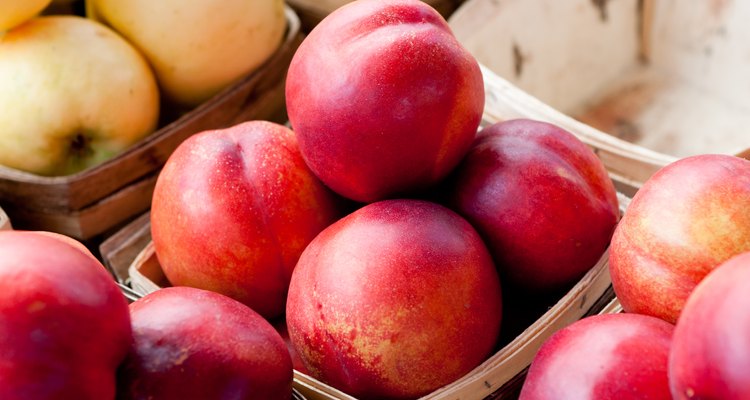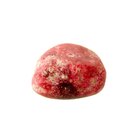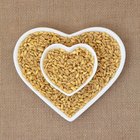
Robert Stone/iStock/Getty Images
Rich in fiber, red plums are a curious blend of sweet, sour and juicy. They are commonly eaten fresh or, when dried, as prunes. Fresh plums are easily found in supermarkets and are frequently inexpensive, especially when in season.
Anthocyanin Content
So-called red plums actually range in color from pale red to a dark purple, with the color of their flesh varying from plum to plum. However, they all have a stronger red tint than yellow-fleshed plums, and the redder the flesh, the more nutritional benefits the plums have. In a 2004 issue of “HortScience,” researchers found that plums with red-colored flesh contained more anthocyanins -- a natural pigment and antioxidant that helps protect your body’s cells from damage from the free radicals that can speed up the aging process -- than did fruit with lighter pigments.
Weight and Heart-Health Benefits
Red plums could potentially help lower your risk of becoming obese or developing Type 2 diabetes or heart problems. In a 2012 publication of “AgriLife TODAY,” Luis Cisneros-Zevallos, AgriLife Research food scientist, found that the phenolic compounds in red plums reduced the effects of low-density lipoprotein in the body. The compounds reduced the chances of developing plaque along the arterial walls, thus lowering the chances of developing hardened arteries and heart disease. Like with anthocyanins, red-flesh plums have a higher phenolic concentration than their yellow-fleshed counterparts.
Basic Nutrients
Red plums are a low-calorie source of dietary fiber. With no fat or cholesterol, a single plum has only 30 calories, 6.5 grams of sugar, 0.5 gram of protein and 1 gram of dietary fiber. While this provides between only 2 and 4 percent of the dietary reference intake of dietary fiber for men and women, proportionally, red plums are a good source of natural fiber. A diet high in fiber can reduce your chance of developing colon disease and diabetes and can potentially help lower your blood cholesterol levels.
Vitamins and Minerals
While red plums only contain small amounts of vitamins and minerals -- less than 10 percent per serving of single plum -- they are still rich in a range of nutrients. With more than 100 milligrams of potassium per plum and trace amounts of zinc, red plums provide you with two essential minerals. Potassium helps regulate your heart’s electrical activity and maintain the acid-base balance. Zinc helps your body’s immune system, and you need it to be able to smell and taste. Red plums are also rich in vitamin A and members of the B-vitamin complex. Vitamin A keeps your eyes healthy, while the B vitamins help your body break down carbohydrates into usable energy. B vitamins also aid in the formation of red blood cells.
Related Articles

Fuji Apples Health Benefits

Nutrition Information on Blueberries

Types of Valuable Crystals

Physical Characteristics of the Ruby ...

Nutrition: Fruit and Vegetable Colors

How to Juice Kiwi Fruit

The Sugar in Mangoes

Is an Orange Healthy to Eat for Your ...

The Effects of Red Lens Sunglasses

Juicing for Wrinkles

How to Identify Red Jasper

Do Fresh Oranges Have a Lot of Sugar in ...

Different Types of Fruits & Vegetables

Kiwis vs. Oranges

Kamut Vs. Wheat

Information About the Orange Fruit

What Are Apple Polyphenols?

Types of Fruit Smoothies

Vitamins for Mental Alertness

Difference Between Clover & Orange ...
References
- AgriLife TODAY: Peaches, Plums, Nectarines Give Obesity, Diabetes Slim Chance
- MedlinePlus: B Vitamins
- USDA Agricultural Research Service: Antioxidant Content of Peach and Plum Genotypes
- MedlinePlus: Antioxidants
- University of Maryland Medical Center: Potassium in Diet
- MedlinePlus: Zinc in Diet
- University of Maryland Medical Center: Vitamin A (Retinol)
Writer Bio
Jessica Lewis has published professionally since 2005 and is a registered dietitian and nutritionist. Her work is regularly found in the "National Post" and "Oxygen Magazine." She holds degrees from the University of Guelph and McMaster University. A marathon runner and yoga enthusiast, she is also interested in alternative medicine.
Photo Credits
Robert Stone/iStock/Getty Images